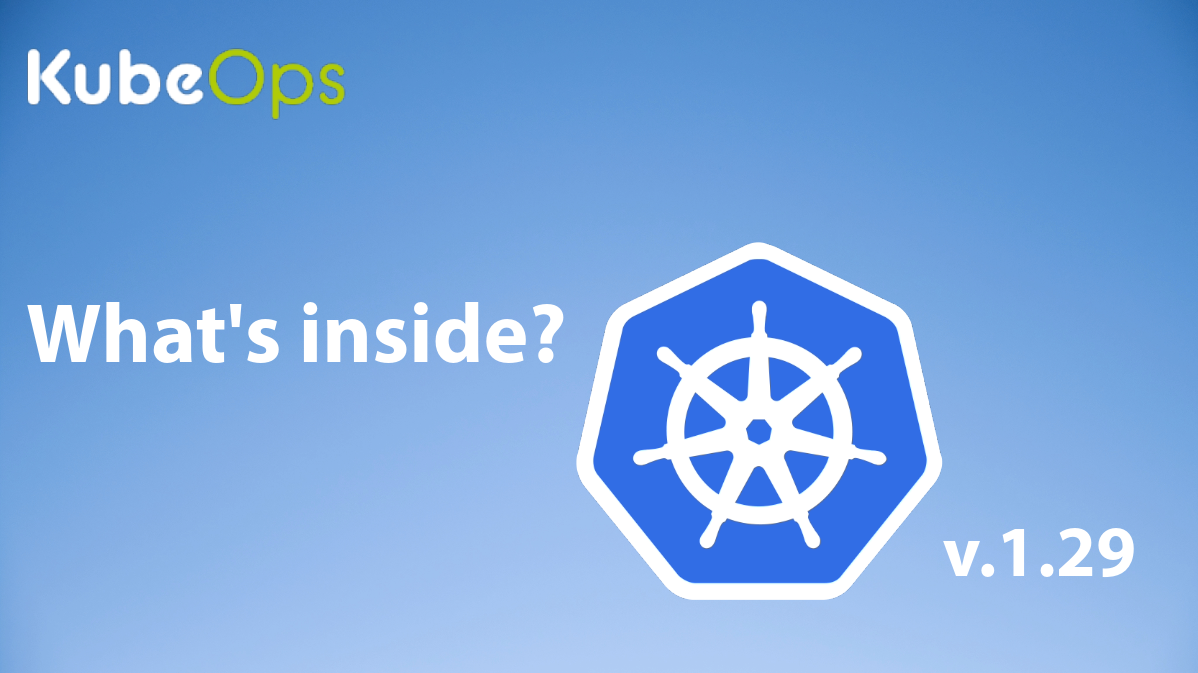Blogs
What's inside Kubernetes v. 1.29?

As Kubernetes continues to evolve, the release of version 1.29 (Mandala (The Universe)) brings a myriad of enhancements and changes that further strengthen its capabilities, particularly in terms of security, operational efficiency, and resource management. This blog post delves into the notable advancements introduced in Kubernetes 1.29.

General Enhancements:
Resource Metrics Endpoint: A pivotal enhancement in Kubernetes 1.29 is the stable release of the Resource Metrics Endpoint. This feature exposes node resource metrics, significantly improving resource management. It plays a crucial role in enhancing security by enabling operators to detect and prevent resource starvation, a potential vector for attacks. Efficient operation of clusters and appropriate resource allocation prevent critical workloads from being under-resourced and vulnerable.
Pod Lifecycle Sleep Action: Another notable addition is the Pod Lifecycle Sleep Action, currently in its alpha stage. This feature introduces a sleep action to delay the termination of pods, which is essential for debugging and ensuring the graceful shutdown of services. Administrators can now investigate and capture the state of pods before termination, aiding in identifying and addressing security issues.
Enhancements Focused on Containers and Communications:
Sidecar Containers: The beta release of Sidecar Containers enhances the management of auxiliary containers that add functionality to a primary container. This improvement ensures that critical services like logging, monitoring, and security agents, which run as sidecars, are more reliably managed throughout the lifecycle of the main application. This enhancement bolsters the reliability of these security services.
Transition from SPDY to WebSockets: Kubernetes 1.29 initiates the transition from SPDY to WebSockets for API server communications, an alpha-stage change. WebSockets offer a more modern, scalable protocol, improving the reliability and maintainability of Kubernetes communications. This switch enhances security by ensuring robust and well-supported communication protocols.
Advancements in Security and Authorization:
Structured Authorization Configuration: Kubernetes 1.29 introduces a more structured configuration model for authorization, moving away from the traditional RBAC (role-based access control) system. This alpha feature enhances manageability and traceability of authorization configurations. With a clearer and more structured approach, security audits become more straightforward, simplifying the enforcement and verification of access policies. This is a significant step towards addressing the complexities associated with managing an expanding number of roles and policies in large-scale Kubernetes deployments.
Bound Service Account Token Improvements: This alpha enhancement in Kubernetes 1.29 aims to secure service account tokens by binding them to specific pod instances. Service account tokens are crucial for authenticating workloads within the cluster. By binding these tokens to the lifecycle of the pod, Kubernetes reduces the risk of these tokens being misused if exfiltrated. This enhancement narrows the window of opportunity for attackers to exploit stolen tokens, thereby increasing the security of cluster operations.
Reduction of Secret-Based Service Account Tokens: Building on the improvements to bound service account tokens, Kubernetes 1.29 also introduces a beta feature that reduces reliance on long-lived secret-based service account tokens. By limiting the use of these tokens, Kubernetes effectively diminishes the potential attack surface. This change aligns with the broader industry trend towards short-lived, just-in-time credentials, minimizing the risk of token leakage and unauthorized access.
Ensure Secret Pulled Images: This alpha feature in Kubernetes 1.29 addresses the security of image pull operations. Container images often contain sensitive components, and this feature ensures that images are always pulled using Kubernetes secrets specific to the Pod using them. This enhancement is particularly important in scenarios where multiple Pods may point to the same image, preventing unauthorized access and ensuring the integrity of container images against interception or tampering.
Support for User Namespaces: Kubernetes 1.29 introduces support for user namespaces in Linux, an alpha feature that enhances security by allowing more granular control over containerized processes. Namespaces in Linux provide a form of virtualization and isolation between different kernel aspects. This feature contributes to better isolation and separation of workloads, reducing the risk of privilege escalation attacks.
Structured Authentication Configuration: Similar to the structured authorization configuration, this alpha feature in Kubernetes 1.29 offers a more maintainable and secure approach to managing authentication. This enhancement enables administrators to implement complex authentication schemes more efficiently, reducing the likelihood of errors in configuration and management of authentication mechanisms.
KMS v2 Improvements: The Kubernetes Key Management Service (KMS) becomes a stable feature with significant improvements in this release. The KMS is essential for the secure management and encryption of secrets. The improvements in Kubernetes 1.29 focus on enhancing the KMS plugin framework, ensuring that Kubernetes secrets remain a robust and secure method for storing sensitive information.
Additional Security and Configuration Features:
Support for User Namespaces: This alpha enhancement supports user namespaces, offering more granular control over containerized processes. It enhances Kubernetes security by improving isolation and reducing the risk of privilege escalation attacks.
Conclusion
Kubernetes 1.29 marks a significant step in the platform's evolution, focusing heavily on security enhancements, operational efficiency, and resource management. These updates not only address current needs but also lay the groundwork for future advancements in Kubernetes’ robust ecosystem. As Kubernetes continues to grow and adapt, these improvements underscore the community's commitment to providing a secure, efficient, and reliable platform for managing containerized applications and services.

